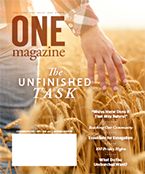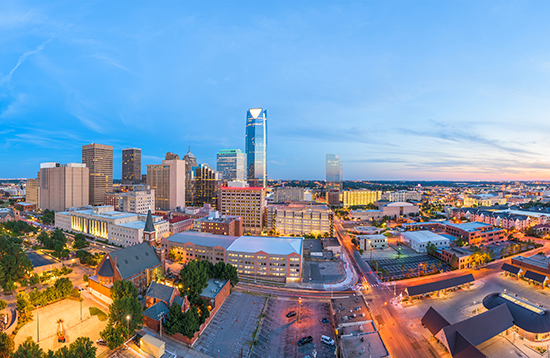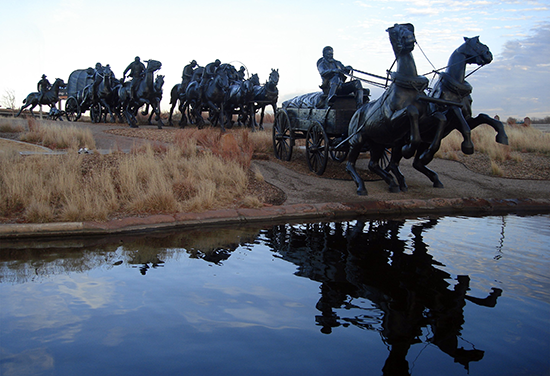
April-May 2020
The Unfinished Task
------------------
|





Saddle Up for the Sooner State: 2020 Convention Preview
When the U.S. government opened Oklahoma Territory to settlers in the late 1800s, it created a large migration into the territory. The action came in response to “Boomers” or pioneers already settled on government land. To distribute the 640-acre parcels of land fairly, the government held a series of “land runs” between 1889 and 1895. Settlers literally raced one another to stake their claims to land. On April 22, 1889, more than 50,000 settlers gathered along the edge of the territory for the first run. What followed was bedlam.
Pioneers in large wagons (prairie schooners), cowboys on horseback, immigrants pulling handcarts, pedestrians, and even riders on velocipedes (primitive large-wheeled bicycles) raced off across the prairie to stake claims. Some, remembered today as “Sooners,” cheated the system and crossed the line early to claim prime location.
In a matter of hours, the sparsely populated region was teeming with people, and the area that eventually came to be Oklahoma City (OKC) was especially popular. Nearly 10,000 pioneers placed claims in the area, and by 1900, the number had doubled. Shortly after Oklahoma became the 46th state in 1907, OKC became the state’s capitol, replacing neighboring Guthrie.
After oil was discovered in Oklahoma, the city boomed as the center of the state’s commerce. Today, OKC numbers among the largest metropolitan areas in the Central Plains. The third-largest city in land area in the lower 48 states, according to Index Mundi, OKC ranks 27th in population, with 650,000 residents in the metropolitan area.
A Free Will Baptist Rush
Free Will Baptists will have their own rush when they pour into OKC, July 19-22, for the 84th national convention. These travelers will soon discover much has changed since the association met in the city a decade ago. So much, in fact, that National Geographic magazine listed OKC as one of the world’s “must-see places” in 2015. The city features a revitalized downtown area that blends its western heritage with modern culture and commerce.
Finding Your Way
One thing hasn’t changed: OKC is easy to find and navigate. Located where Interstates 35, 40, and 44 come together, the city is convenient for drivers. For those flying, Will Rogers International Airport is a short shuttle ride from the city and offers non-stop flights from most major cities.
From city center, most popular destinations are only a brief walk away. Visitors also can ride the new OKC Street Car system, which opened in 2017 and offers unlimited rides for only $3 per day. Download a trolley schedule and route map at okcstreetcar.com.


A Destination to Enjoy
With 250 museums, Frontier City (Six Flags theme park), great food, and a world-class zoo, OKC is a great place to take the family. The little buckaroos will enjoy the National Cowboy and Western Heritage Museum while the 215,000-square-foot Oklahoma History Center will bring the state’s colorful history to life. Be prepared for kids to splash through the city’s 16 “Spraygrounds,” interactive water parks with assorted spray features. Be prepared to get wet!
Sports Scene
Golfers will be delighted to learn the number of public courses in the greater Oklahoma City area has grown from 17 to 22. Baseball fans will want to take in a game at Chickasaw Bricktown Ballpark, known affectionately as “The Brick.” The park is home to the Triple-A Oklahoma City Dodgers. OKC also boasts the Lazy-E Arena, long considered the world’s premier rodeo facility, hosting more than 40 championship events each year.
If golf, baseball, and rodeo aren’t enough, check out the Jim Thorpe Museum or the National Softball Hall of Fame—something for everyone!
Budget Traveler
Those traveling on a tight budget will enjoy the following free or low-cost activities scattered across the city:
The Centennial Land Run Monument (pictured above). Commemorating the chaos of the race for land, this monument is the largest series of sculptures in the world, consisting of 47 statues spread across a distance of 365 feet.
Historic Oklahoma City Stockyards are just minutes from downtown. Visitors can see cowboys and craftsmen at work and browse a large variety of western shops.
Just south of downtown, Skydance Bridge (pictured above) soars over Interstate 40. The 380-foot-long pedestrian walkway features a 197-foot-tall sculpture inspired by Oklahoma’s state bird, the scissor-tailed flycatcher.
Martin Park Nature Center and wildlife sanctuary includes miles of hiking trails, a museum, library, and more. The park is open Wednesday through Sunday (9-6).
At Oklahoma Railway Museum, kids can explore old passenger cars and a working steam engine. Admission is free; donations are welcome: oklahomarailwaymuseum.org.
Love disc golf? Let it fly at one of the city’s three disc golf courses: Dolese Youth Park, Will Rogers Park, and Woodson Park.
The Paseo Arts District is home to over 20 galleries and 80 vibrant artists within walking distance. The curved, two-block street has maintained Spanish revival architecture with original stucco buildings and clay roof tiles: thepaseo.org.
Enjoy a relaxing walk along more than 70 miles of trails winding throughout Oklahoma City from the shoreline of Lake Hefner to the banks of the Oklahoma River.
Find more great suggestions at visitokc.com.
Make Time for the Memorial
The OKC National Memorial and Museum honors victims of the 1995 bombing of the Alfred P. Murrah Federal Building. The large museum recalls the sights and sounds of that fateful day through voices, images, and artifacts. The free outdoor memorial is open seven days a week, and the museum is open Monday–Saturday (9-6) and Sunday (noon-6). Admission is $15.
|
|

